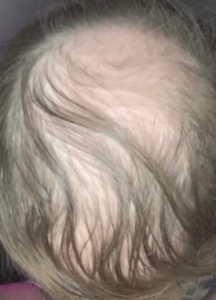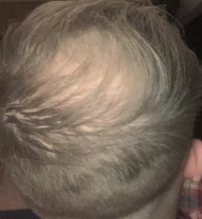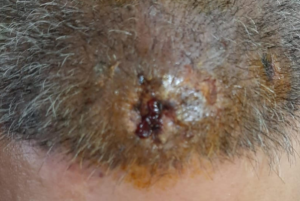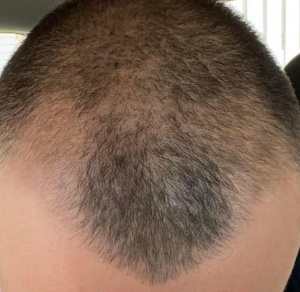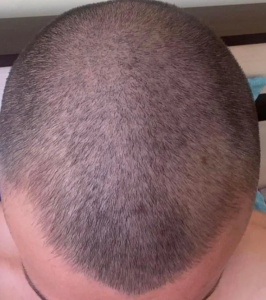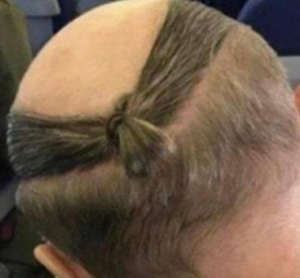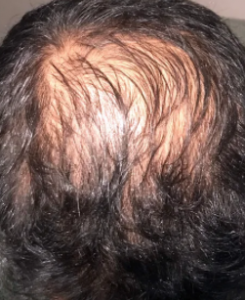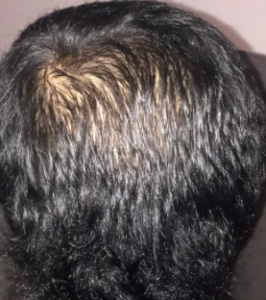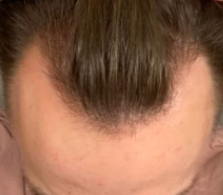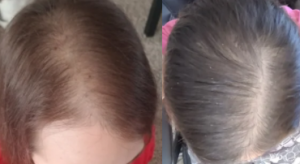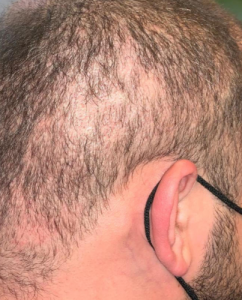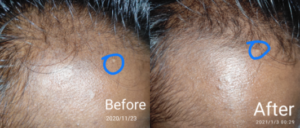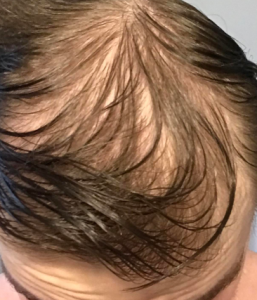Necrosis is cell death in this case the result of probably the way the recipient sites were make. In over 16,000 hair transplant surgeries performed by our group, we have never seen a case of necrosis. The majority of times, this is a technical failure in the use of instruments combined with too much epinephrine in the anesthetic solutions used; however, there are diseases that can cause this which the surgeon must be aware of. This would will take about 2 months to heal with good surgical management. A scar will be left behind which can be transplanted.
Dr. Robert True wrote a very interesting article in the May/June issue of the Hair Transplant FORUM. He suggested that today’s surgeons should consider using the hair outside the SAFE DONOR ZONE. The rational is reasonable even though we expose our patients to some eventual loss of hair if their inherited hair loss pattern would become an advanced Class 6 or 7 pattern. I have always believed that this is a slippery slope because patients might get angry or depressed if they lost their transplanted hair earlier than their 60s of 70s or even later. The advanced Class 6 pattern as well as the advanced Class 7 pattern of balding, does occur in young men and if they were to progress to one of these patterns of balding (for example) two things would become evident: (1) if they had an FUE, the area that the hair came from would show the scars from the FUE punch and they would be very detectable to any observer, and (2) some of the transplanted hair would fall out after it grew for a while (because the hair that would fall out was genetically destined to die early.
The solution to the scars are relatively easy, just use Scalp Micropigmentation to hide these scars. The solution to the advancing hair loss would require a series of actions between the doctor and the patient at the time of the hair transplant. First, any patient willing to have this done knowingly (emphatic that the patient needs to understand this process 100%) then the surgeon can plan for future transplant loss by segregating the grafts as they are put in place. For example, the hairs that are removed from the 3 inch high PERMANENT DONOR ZONE (it is really 2 1/2 inches for advanced Class 7 pattern balding), could be placed in the front and top of the head (from the frontal hairline to mid-head) leaving the questionable hair that could be lost in the back of the head. If these hairs were well mixed together randomly at the time of the hair transplant, then the loss would be relatively uniform. As such, as the man got older (say 2-20 years after the hair transplant) and his eventually Class 7 pattern emerged (the example I am using), he would have had a fuller head of hair for as long as these non-permanent hairs lived. Nobody can predict the time until some or all of these non-permanent hairs will live, but hopefully the man would see a uniform thinning and eventual balding reoccurring at a time that is more acceptable to him.
Unfortunately, many surgeons today are doing such harvesting with FUE anyway without telling the patients that this may result in a loss of some of the transplant hair in the future. The doctors do this for many reasons, economic or otherwise.
I tell my patients that 2-3 days is a good number. Minoxidil produces dependent hairs and you don’t want to lose them
This article reports on 4 patients who had occlusion of the ophthalmic artery with irreversible blindness after PRP injection of the face, the most common cosmetic procedure performed today. It shows the risks associated with PRP into the face. In addition to the case report in the article below, another doctor reported 3 more cases of blindness associated with facial PRP especially when injected in the glabella (area are of the forehead near the upper bridge of the nose.
ttps://www.ncbi.nlm.nih.gov/pmc/articles/PMC7722697/https://www.ncbi.nlm.nih.gov/pmc/articles/PMC7722697/?fbclid=IwAR3mlM8QufQirPvusQ81fhkGzpHhyQEo6r70y7_EA2ssLkNDYfLYq8T5L8s
If you’re a Norwood 7 do you still have the 100,000 hairs that you were born with but they are miniaturized stuck in the telogen phase for decades or does DHT completely destroy the follicle?
If you are a Caucasian and have a typical donor density with 110,000 hairs on your head and then you develop a Class 7 pattern, the follicles that disappeared may be there and alive in the form of inactive stem cells for a number of years. After some time (don’t know the time-line), these stem cells are thought to die off. Maybe 10, 20 or 30 years have to pass. We don’t know. I am about to treat such men to find out with a possibly cure for hair loss so in a year, maybe I can tell you what I found.
You have to give it between 12-18 months to see if it will reverse. Add topical minoxidil along with microneedling and you have a better chance of reversal
What do I do, How do I start?
You need a good doctor and anything short of an experienced doctor to help you manage your hair loss is a mistake you will take with you every year you get older. Regrets are when you don’t do the right thing and lose your hairy look when maybe you don’t have to. At your age, your’e in trouble as anyone can see. With this much hair loss at your age, you may be heading to a very bald man. Have you thought about it?
Page 141 of 634

